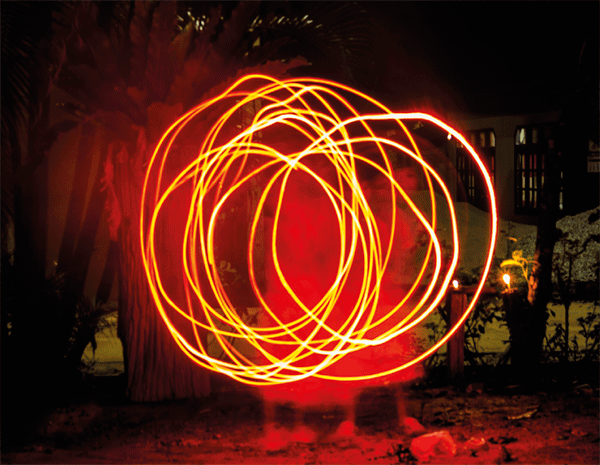10.3
The Three-Box Model of Memory
The information-processing model of three separate memory systems—sensory, short-term, and long-term—remains a leading approach because it offers a convenient way to organize the major findings on memory, does a good job of accounting for these findings, and is consistent with the biological facts about memory. Let us now peer into each of the “boxes”; you can get a sneak peek by watching the video Memory 1.
Watch
Memory 1
The Sensory Register: Fleeting Impressions
In the three-box model, all incoming sensory information must make a brief stop in the sensory register, the entryway of memory. The sensory register includes a number of separate memory subsystems, as many as there are senses. Visual images remain in a visual subsystem for a maximum of a half second. Auditory images remain in an auditory subsystem for a slightly longer time, by most estimates up to two seconds or so.
The sensory register acts as a holding bin, retaining information in a highly accurate form until we can select items for attention from the stream of stimuli bombarding our senses. It gives us a moment to decide whether information is extraneous or important; not everything detected by our senses warrants our attention. And the identification of a stimulus on the basis of information already contained in long-term memory occurs during the transfer of information from the sensory register to short-term memory.
Information that does not quickly go on to short-term memory vanishes forever, like a message written in disappearing ink. That is why people who see an array of 12 letters for just a fraction of a second can only report four or five of them; by the time they answer, their sensory memories are already fading (Sperling, 1960). The fleeting nature of incoming sensations is actually beneficial; it prevents multiple sensory images—“double exposures”—that might interfere with the accurate perception and encoding of information.

In a dark room or closet, swing a flashlight rapidly in a circle. You will see an unbroken circle of light instead of a series of separate points. The reason: The successive images remain briefly in the sensory register.
Short-Term Memory: Memory's Notepad
Like the sensory register, short-term memory (STM) retains information only temporarily—for up to about 30 seconds by many estimates, although some researchers think that the maximum interval may extend to a few minutes for certain tasks. In short-term memory, the material is no longer an exact sensory image but is an encoding of one, such as a word or a phrase. This material either transfers into long-term memory or decays and is lost forever.
Victims of brain injury demonstrate the importance of transferring new information from short-term memory into long-term memory. H. M. was able to store information on a short-term basis; he could hold a conversation and his behavior appeared normal when you first met him. Yet, for the most part, he could not retain explicit information about new facts and events for longer than a few minutes. His terrible memory deficits involved a problem in transferring explicit memories from short-term storage into long-term storage. With a great deal of repetition and drill, patients like H. M. can learn some new visual information, retain it in long-term memory, and recall it normally (McKee & Squire, 1992). But usually information does not get into long-term memory in the first place.
The Leaky Bucket People such as H. M. fall at the extreme end on a continuum of forgetfulness, but even those of us with normal memories know from personal experience how frustratingly brief short-term retention can be. We look up a phone number, and before we can use it we find that the number has vanished from our minds. We meet someone at a party and two minutes later find ourselves groping for the person's name. Is it any wonder that short-term memory has been called a “leaky bucket”?
According to most memory models, if the bucket did not leak it would quickly overflow because at any given moment, short-term memory can hold only so many items. Years ago, George Miller (1956) estimated its capacity to be “the magical number 7 plus or minus 2.” Conveniently, 5-digit zip codes and 7-digit phone numbers fall in this range (at least in the United States); 16-digit credit card numbers do not. Since then, estimates of STM's capacity have ranged from 2 items to 20, with one estimate putting the “magical number” at 4 (Cowan, 2001; Cowan et al., 2008; Mathy & Feldman, 2012). Everyone agrees, however, that the number of items that short-term memory can handle at any one time is small.
Digit Span Test

Given the limits on short-term memory, how do we remember the beginning of a spoken sentence until the speaker reaches the end? After all, most sentences are longer than just a few words. Most information-processing models of memory propose that we bind small bits of information into larger units, or chunks. The real capacity of STM, it turns out, is not a few bits of information but a few chunks (Gilchrist & Cowan, 2012). A chunk can be a word, a phrase, a sentence, or even an image, and it depends on previous experience. For most Americans, the number 1776 is one chunk, not four, but 1840 is probably four chunks—unless you're from New Zealand, in which case 1840 is one chunk. (In that year, the British Crown and native Maori chiefs signed a treaty that became New Zealand's founding document.) A chunk can be visual: If you know football, when you see a play unfolding, you might see a single chunk of information—say, a wishbone formation—and be able to remember it. If you do not know football, you will see only a field full of players, and you probably won't be able to remember their positions when you look away.
But even chunking cannot keep short-term memory from eventually filling up. Information that will be needed for longer periods must be transferred to long-term memory or it will be displaced by new information and spill out of the bucket. Particularly meaningful items may transfer quickly, but other information will usually require more processing—unless we do something to keep it in STM for a while, as we will discuss shortly.
Working Memory In the original three-box model, short-term memory functioned basically as a container for temporarily holding on to new information or information retrieved from long-term memory. But this view did not account for the sense of effort we feel when trying to solve a problem. Does 2 × (3 + 5) / 4 = 4? Solving that problem feels as though we are not simply holding on to information but also working with it, which is why psychologists today think that STM is really part of a working memory system. STM keeps its job as a temporary holding bin, but another more active part—an “executive”—controls attention, focusing it on the information we need for the task at hand and warding off distracting information (Baddeley, 1992, 2007; Ma, Husain, & Bays, 2014). In the previous algebra problem, your working memory must contain the numbers and instructions for operating on them, and also carry out those operations and retain the intermediate results from each step.
People who do well on tests of working memory tend to do well on intelligence tests and on tasks requiring complex cognition and the control of attention, such as understanding what you read, following directions, taking notes, playing bridge, learning new words, estimating how much time has elapsed, and many other real-life tasks (Broadway & Engle, 2011). When they are engrossed in challenging activities that require their concentration and effort, they stay on task longer, and their minds are less likely than other people's to wander (Kane et al., 2007).
The ability to bring information from long-term memory into short-term memory or to use working memory is not disrupted in patients like H. M. They can do arithmetic, relate events that predate their injury, and do anything else that requires retrieval of information from long-term into short-term memory. Their problem is with the flow of information in the other direction, from short-term to long-term memory.

These card players are having a great time using their working memories.
Long-Term Memory: Memory's Storage System
The third box in the three-box model of memory is long-term memory (LTM). The capacity of long-term memory seems to have no practical limits. The vast amount of information stored there enables us to learn, get around in the environment, and build a sense of identity and a personal history.
Organization in Long-Term Memory Because long-term memory contains so much information, it must be organized in some way, so that we can find the particular items we are looking for. One way to organize words (or the concepts they represent) is by the semantic categories to which they belong. Chair, for example, belongs to the category furniture. In a study done many years ago, people had to memorize 60 words that came from four semantic categories: animals, vegetables, names, and professions. The words were presented in random order, but when people were allowed to recall the items in any order they wished, they tended to recall them in clusters corresponding to the four categories (Bousfield, 1953). This finding has been replicated many times.
Evidence on the storage of information by semantic category also comes from cases of people with brain damage. In one such case, a patient called M. D. appeared to have made a complete recovery after suffering several strokes, with one odd exception: He had trouble remembering the names of fruits and vegetables. M. D. could easily name a picture of an abacus or a sphinx, but he drew a blank when he saw a picture of an orange or a carrot. He could sort pictures of animals, vehicles, and other objects into their appropriate categories, but did poorly with pictures of fruits and vegetables. On the other hand, when M. D. was given the names of fruits and vegetables, he immediately pointed to the corresponding pictures (Hart, Berndt, & Caramazza, 1985). Apparently, M. D. still had information about fruits and vegetables, but his brain lesion prevented him from using their names to get to the information when he needed it, unless someone else provided the names. This evidence suggests that information in memory about a particular concept (such as orange) is linked in some way to information about the concept's semantic category (such as fruit).
Indeed, many models of long-term memory represent its contents as a vast network of interrelated concepts and propositions (Anderson, 1990; Collins & Loftus, 1975). In these models, a small part of a conceptual network for animals might look something like the one in Figure10.4. The way people use these networks, however, depends on experience and education. In rural Liberia, one study showed that the more schooling children had, the more likely they were to use semantic categories in recalling lists of objects (Cole & Scribner, 1974). This makes sense because in school, children must memorize a lot of information in a short time, and semantic grouping can help. Unschooled children, having less need to memorize lists, do not cluster items and do not remember them as well. But this does not mean that unschooled children have poor memories. When the task is one that is meaningful to them, such as recalling objects that were in a story or a village scene, they remember extremely well (Mistry & Rogoff, 1994).
Figure10.4
The Organization of Semantic Memory

We organize information in long-term memory not only by semantic groupings but also in terms of the way words sound or look. Have you ever tried to recall some name, phrase, or word that just escaped you? Nearly everyone experiences these tip-of-the-tongue (TOT) states, which occur across many languages and cultures; users of sign language call them “tip of the finger” states (Thompson, Emmorey, & Gollan, 2005). Scientists value them as a sort of slow-motion video of memory processes (A. Brown, 2012; Resnik et al., 2014). People in a TOT state tend to come up with words that resemble the right one in sound, meaning, or form (e.g., number of syllables) before finally recalling the one they're searching for, which indicates that information in long-term memory is organized in those terms (R. Brown & McNeill, 1966). For the name Kevin they might say, “Wait, it starts with a K and has two syllables . . . Kenny? Kerran? . . . ”
Information in long-term memory may also be organized by its familiarity, relevance, or association with other information. The method used in any given instance probably depends on the nature of the memory; you would no doubt store information about the major cities of Europe differently from information about your first date. To understand the organization of long-term memory, then, we must know what kinds of information can be stored there.

Culture affects the encoding, storage, and retrieval of information in long-term memory. Navajo healers, who use stylized, symbolic sand paintings in their rituals, must commit to memory dozens of intricate visual designs because no exact copies are made and the painting is destroyed after each ceremony.
The Contents of Long-Term Memory Most theories of memory distinguish skills or habits (“knowing how”) from abstract or representational knowledge (“knowing that”). Procedural memories are memories of knowing how to do something—comb your hair, use a pencil, solve a jigsaw puzzle, knit a sweater, or swim. Many researchers consider procedural memories to be implicit, because once skills and habits are learned well, they do not require much conscious processing. Declarative memories involve knowing that something is true, as in knowing that Ottawa is the capital of Canada; they are usually assumed to be explicit.
Declarative memories come in two varieties: semantic memories and episodic memories (Tulving, 1985). Semantic memories are internal representations of the world, independent of any particular context. They include facts, rules, and concepts—items of general knowledge. On the basis of your semantic memory of the concept cat, you can describe a cat as a small, furry mammal that typically spends its time eating, sleeping, prowling, and staring into space, even though a cat may not be present when you give this description, and you probably won't know how or when you first learned it.
Episodic memories are internal representations of personally experienced events. When you remember how your cat once surprised you in the middle of the night by pouncing on you as you slept, you are retrieving an episodic memory. Figure10.5 summarizes these kinds of memories.
Figure 10.5
Types of Long-Term Memory

Episodic memory allows us to travel not only backward in time, but also forward, to imagine possible future experiences (Schacter et al., 2015). We mine our episodic memories to construct scenarios of what might happen and then rehearse how we might behave. In fact, regions of the brain known to be involved when we retrieve personal memories, notably the hippocampus and parts of the prefrontal cortex and temporal lobe, are also activated when we imagine future events (Addis, Wong, & Schacter, 2007). Patients who cannot retrieve any episodic memories because of damage to the hippocampus often cannot envision future episodes either, even in response to such simple questions as “What will you do tomorrow?” (Hassabis & Maguire, 2007). The “time-travel” function of episodic memories is often beneficial and motivating because people tend to forget negative episodic memories faster than positive ones, leaving us with a forgiving past and rosy future (Szpunar, Addis, & Schacter, 2012).
From Short-Term to Long-Term Memory: A Puzzle The three-box model of memory is often invoked to explain an interesting phenomenon called the serial-position effect. If you are shown a list of items and are then asked immediately to recall them, your recall will be best for items at the beginning of the list (the primacy effect) and at the end of the list (the recency effect); the items in the middle of the list will tend to drop away (Bhatarah, Ward, & Tan, 2008; Johnson & Miles, 2009). If we plot the results, we see a U-shaped curve as shown in Figure10.6. A serial-position effect occurs when you meet a lot of people at a party and find you can recall the names of the first few and the last few, but almost no one in between.
Figure 10.6
The Serial-Position Effect

When people try to recall a list of similar items immediately after learning it, they tend to remember the first and last items best and the ones in the middle worst.
Primary and recency effects apparently occur for different reasons. Primacy effects happen because the first few items in a list are rehearsed many times and so are likely to make it to long-term memory and remain memorable. Recency effects occur because at the time of recall, they are plucked out of short-term memory, where they are still sitting. The items in the middle of a list are not so well retained because by the time they get into short-term memory, it is already crowded with the first few items. As a result, middle items often drop out of short-term memory before they can be stored in long-term memory. Indeed, a functional MRI (fMRI) study found that recognition memory for words early in a list activated areas in the hippocampus associated with retrieval from long-term memory, but recognition for words that came near the end of the list did not (Talmi et al., 2005).
The problem with this explanation is that the recency effect sometimes occurs even after a considerable delay, when the items at the end of a list should no longer be in short-term memory (Davelaar et al., 2004). Moreover, the serial-position effect can occur not just with semantic memories but also episodic ones—memories of past personal experiences, such as the soccer games you played in over the last season. The serial-position curve, therefore, remains something of a puzzle.
The Serial Position Effect
